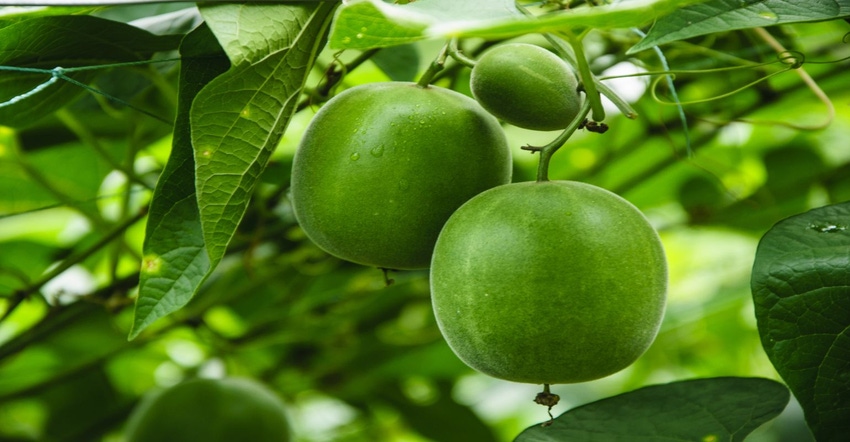Although newer to the food and beverage scene, monk fruit—and its sweetening superpower—has been around for ages.

Ironically, one of the most desirable food and beverage tastes is sweetness, yet the excessive ingestion of sugar negatively affects human health.1 Food and beverage industry experts know better than anyone how challenging it can be to achieve a sweet taste in products without the repercussions of added sugar.
That’s where monk fruit, also known as Luo Han Guo or swingle fruit, comes in. Freely soluble in water, most monk fruit extract takes the form of an off-white to light yellow powder, but this sweetener also comes in liquid, concentrate and granulated forms. Monk fruit has become a significant ingredient for research because of the pharmacological and economic potential of its non-caloric, extremely sweet components, namely mogrosides.2
The origin of monk fruit
Native to the remote mountains of China and Thailand, monk fruit allegedly gets its name from the Buddhist monks who were the first to cultivate it nearly 800 years ago.3 The warmer temperatures and higher elevation in Southeast Asia lend well to the growth of the fruit. An herbaceous perennial vine of the gourd family Cucurbitaceae, monk fruit is derived from a plant called Siraitia grosvenorii. Monk fruit extracts are prepared by water extraction of the fruits of said plant, specifically by removing the seeds and skin of the fruit, crushing the fruit and collecting the juice.4 The principal sweetening component at play is mogroside V—a different molecule than glucose, though, so it does not act like sugar. Research has shown that mogrosides have antioxidant effects, making monk fruit an even more desirable ingredient.5
Some sweet benefits
Although monk fruit is newer to the food and beverage scene, it has been around for ages. In traditional Chinese medicine (TCM), monk fruit was used to relieve cough, sore throat and other upper respiratory issues.2
Coming in at 150-250 times sweeter than sucrose and up to 300 times sweeter than sugar, a little monk fruit goes a long way. Plus, the ingredient has zero calories per serving, giving it a zero glycemic index. The calorie-free nature of this sweetener makes it an option for people with diabetes and preferable for anyone on a low-carb diet. Monk fruit has also been deemed GRAS (generally recognized as safe) by FDA.6 Even better news for food and beverage producers—most people think it has a better aftertaste profile than other natural options. The flavor of monk fruit provides sweetness without the lingering bitterness.
Most often, monk fruit shows up in confectionery, dairy, cereals, tabletop and baked goods. Last year, an entire clinical study was done on the viability of monk fruit extract as a sweetener for yogurt, taking its physicochemical, rheological, microstructural and antioxidant properties into consideration.7 Essentially, yogurt sweetened with monk fruit had higher levels of antioxidants than yogurt sweetened with sucrose, and still tasted appealing. And the concentrated nature of monk fruit leaves room for other product enhancements, like additional complex carbohydrates, fibers and whole grains in any given food or beverage.
To read this article in its entirety, check out the “Sweet innovation: Natural solutions in sugar reduction” digital magazine.
Mike Efting has been a senior executive in the chemical distribution industry for more than 35 years and an entrepreneur for well over a decade. He is the current president and founder of Viachem, a specialty chemical food additive and ingredient distributor, and American Pure Products, a wholly owned subsidiary of Viachem that includes premium personal care brands spanning hand sanitizer to CBD.
References
1 Buchilina A and Aryana K. “Physicochemical and microbiological characteristics of camel milk yogurt as influenced by monk fruit sweetener.” J Dairy Sci. 2020;104(2):1484-1493.
2 Xia M et al. “Improved de novo genome assembly and analysis of the Chinese cucurbit Siraitia grosvenorii, also known as monk fruit or luo-han-guo.” GigaScience. 2018;7(6):giy067.
3 Balachandran K. “Natural Sweeteners.” J Soc Health Diabetes. 2018;6(1):8-10.
4 Younes M et al. “Safety of use of Monk fruit extract as a food additive in different food categories.” EFSA J. 2019;17(12):e05921.
5 Xu Q et al. “Antioxidant effect of mogrosides against oxidative stress induced by palmitic acid in mouse insulinoma NIT-1 cells.” Braz J Med Biol Res. 2013;46(11):949-955.
6 Li XE et al. “Parents’ and Children’s Acceptance of Skim Chocolate Milks Sweetened by Monk Fruit and Stevia Leaf Extracts.” J Food Sci. 2015;80(5):S1083-S1092.
7 Ban Q et al. “Physiochemical, rheological, microstructural, and antioxidant properties of yogurt using monk fruit extract as a sweetener.” J Dairy Sci. 2020;103(11):10006-10014.
About the Author(s)
You May Also Like






